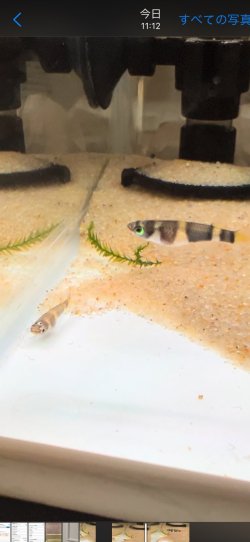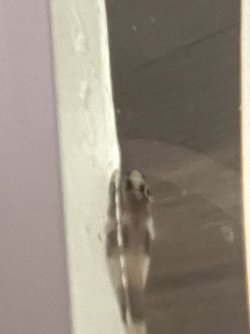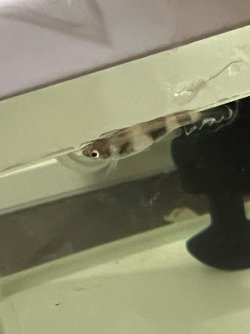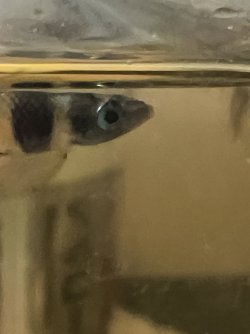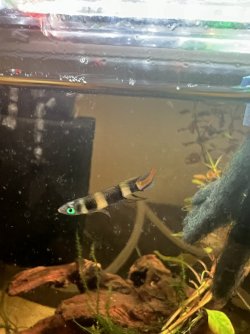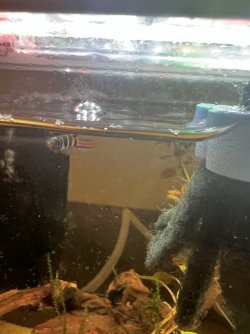confused_aquarist
New Member
Hi there I’m Sue new to the forum. (Long wall of text ensues!) I’m wondering what this disease might be that’s affecting one of my killifish.
Couple of months ago I started a new aquarium and got 5 clown killies (siblings from a same breed) from an online pet store. The day that I got these fish I noticed that they were all sort of acting strange, not moving very much and not eating. Some of them never ate, some had stringy white poop and all but 1 female died one by one within 2 weeks. I should note that a common symptom seemed to be a bump below their mouths but never really figured out what that was. Also notably a day later I found the surviving female trying to spit out some white stringy stuff but failing over and over again as it went right back to her mouth. I never saw her do it again (and still haven’t to this day) so after a week I thought it might be smart to mix this surviving killi with another 5 clown killies I got from different pet store (a total beginner here so don’t be too harsh on me for this decision). For a month or so, they were actually doing fine. The surviving female started moving around a bit more after I mixed all 6 killies, and it had 4 fry in the meantime. I suppose I should mention that one of these fry has a tumor-looking bump, lies sideways on bottom of tank, and does not grow very much and so is not likely to survive for long.
So one day (exactly a month ago) this female started acting weird again and became less active, was hiding in moss all the time and developed a bump on its mouth, just like its 4 other siblings that died earlier. It also developed 4 red/black spots on its forehead, and lips turned blood red though didn’t seem to be injury or fungus as it definitely didn’t appear to be an outgrowth (light colored Lillie in the 1st photo). 2 of these spots are near where its nose would be, and two other ones follow right behind them, and they’re symmetrical. Can’t tell if they’re holes or if internal since these holes are just way too tiny for poor me to see on this small fish.
A day later, a tank mate developed gill disease and two days later died from dropsy. The 4 remaining tank mates still appear normal to this day.
So in the meantime I quarantined this female and gave an antibiotic bath treatment, and while in this bath the female developed fin rot in addition to the mouth bump that it already had, but within 2 weeks both the fin rot and mouth bump went away. But then it started pooping out white strings and so I bought a microscope and found fast-moving flagellates coming out from its poop. The tiny flagellates and would stop moving in a few minutes after coming out of poop so I assumed it was something anaerobic.
So, fast-forwarding 2 weeks later, here is what this female looks like now (photo 2). It doesn’t eat at all anymore, has a bent tail (always bending to the left) and the 4 red/black spots on its forehead which never went away with antibiotics have turned even darker. Also I noted 2 tiny black dots on its belly, right at the bottom of its 2nd band (photo 3). I can’t tell since the fish is small, but the dots seem to be internal as the bottom part of its belly is translucent, or at least that’s my suspicion. This killie has been floating around for a few days and I’m honestly now considering euthanizing it since it’s probably going to be gone in a few days anyway.
I tried to do some treatments with metronidazole, but here in Japan unfortunately it took 2 weeks for me to obtain the drug from an overseas seller and by the time it arrived the fish pretty much wasn’t eating at all. Still tried to put some in the quarantine bath but not too sure if that was having any effect.
At the moment I’m suspecting hexamita, but not sure if that’s the whole story here. Here in Japan we have almost no fish drugs, just some anti-ich and antibiotics for treating columbaria and sorts, so honestly I wouldn’t be surprised regardless of what this is. To be completely precise, my prediction based on these symptoms would be hexamita with concurrent fish TB infection but would appreciate any input to help figure out what this could be. So many mysterious symptoms!
Couple of months ago I started a new aquarium and got 5 clown killies (siblings from a same breed) from an online pet store. The day that I got these fish I noticed that they were all sort of acting strange, not moving very much and not eating. Some of them never ate, some had stringy white poop and all but 1 female died one by one within 2 weeks. I should note that a common symptom seemed to be a bump below their mouths but never really figured out what that was. Also notably a day later I found the surviving female trying to spit out some white stringy stuff but failing over and over again as it went right back to her mouth. I never saw her do it again (and still haven’t to this day) so after a week I thought it might be smart to mix this surviving killi with another 5 clown killies I got from different pet store (a total beginner here so don’t be too harsh on me for this decision). For a month or so, they were actually doing fine. The surviving female started moving around a bit more after I mixed all 6 killies, and it had 4 fry in the meantime. I suppose I should mention that one of these fry has a tumor-looking bump, lies sideways on bottom of tank, and does not grow very much and so is not likely to survive for long.
So one day (exactly a month ago) this female started acting weird again and became less active, was hiding in moss all the time and developed a bump on its mouth, just like its 4 other siblings that died earlier. It also developed 4 red/black spots on its forehead, and lips turned blood red though didn’t seem to be injury or fungus as it definitely didn’t appear to be an outgrowth (light colored Lillie in the 1st photo). 2 of these spots are near where its nose would be, and two other ones follow right behind them, and they’re symmetrical. Can’t tell if they’re holes or if internal since these holes are just way too tiny for poor me to see on this small fish.
A day later, a tank mate developed gill disease and two days later died from dropsy. The 4 remaining tank mates still appear normal to this day.
So in the meantime I quarantined this female and gave an antibiotic bath treatment, and while in this bath the female developed fin rot in addition to the mouth bump that it already had, but within 2 weeks both the fin rot and mouth bump went away. But then it started pooping out white strings and so I bought a microscope and found fast-moving flagellates coming out from its poop. The tiny flagellates and would stop moving in a few minutes after coming out of poop so I assumed it was something anaerobic.
So, fast-forwarding 2 weeks later, here is what this female looks like now (photo 2). It doesn’t eat at all anymore, has a bent tail (always bending to the left) and the 4 red/black spots on its forehead which never went away with antibiotics have turned even darker. Also I noted 2 tiny black dots on its belly, right at the bottom of its 2nd band (photo 3). I can’t tell since the fish is small, but the dots seem to be internal as the bottom part of its belly is translucent, or at least that’s my suspicion. This killie has been floating around for a few days and I’m honestly now considering euthanizing it since it’s probably going to be gone in a few days anyway.
I tried to do some treatments with metronidazole, but here in Japan unfortunately it took 2 weeks for me to obtain the drug from an overseas seller and by the time it arrived the fish pretty much wasn’t eating at all. Still tried to put some in the quarantine bath but not too sure if that was having any effect.
At the moment I’m suspecting hexamita, but not sure if that’s the whole story here. Here in Japan we have almost no fish drugs, just some anti-ich and antibiotics for treating columbaria and sorts, so honestly I wouldn’t be surprised regardless of what this is. To be completely precise, my prediction based on these symptoms would be hexamita with concurrent fish TB infection but would appreciate any input to help figure out what this could be. So many mysterious symptoms!

